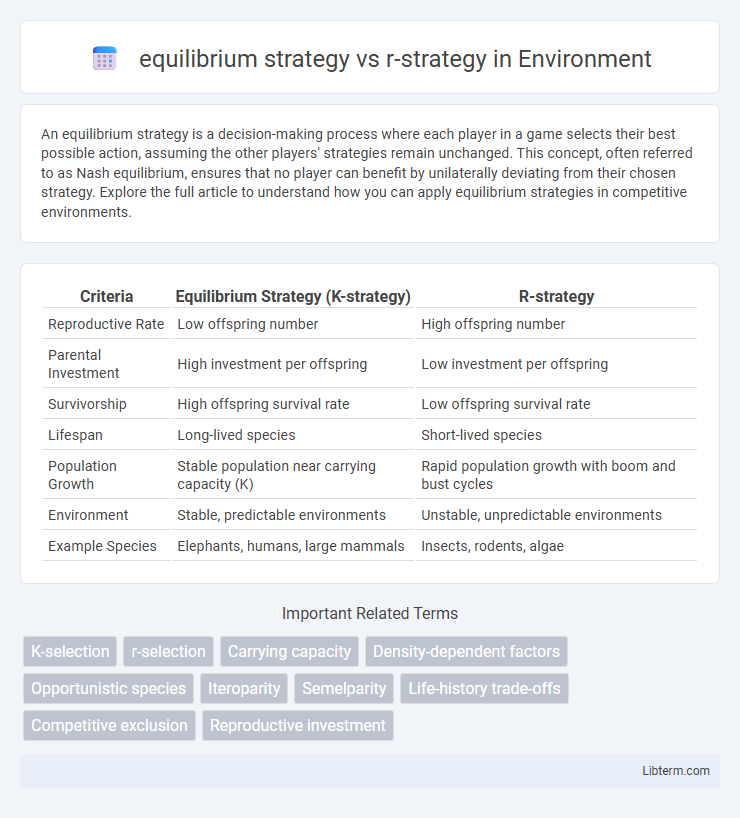An equilibrium strategy is a decision-making process where each player in a game selects their best possible action, assuming the other players' strategies remain unchanged. This concept, often referred to as Nash equilibrium, ensures that no player can benefit by unilaterally deviating from their chosen strategy. Explore the full article to understand how you can apply equilibrium strategies in competitive environments.
Table of Comparison
| Criteria | Equilibrium Strategy (K-strategy) | R-strategy |
|---|---|---|
| Reproductive Rate | Low offspring number | High offspring number |
| Parental Investment | High investment per offspring | Low investment per offspring |
| Survivorship | High offspring survival rate | Low offspring survival rate |
| Lifespan | Long-lived species | Short-lived species |
| Population Growth | Stable population near carrying capacity (K) | Rapid population growth with boom and bust cycles |
| Environment | Stable, predictable environments | Unstable, unpredictable environments |
| Example Species | Elephants, humans, large mammals | Insects, rodents, algae |
Understanding Equilibrium Strategy and r-Strategy
Equilibrium strategy, often linked to K-strategy, involves organisms investing in fewer offspring with higher survival rates by prioritizing resource allocation and parental care to maximize fitness in stable environments. In contrast, r-strategy emphasizes producing many offspring with minimal investment per individual to exploit unpredictable or changing environments where survival rates are low. Understanding these strategies highlights evolutionary trade-offs between quantity and quality of offspring, influencing species' population dynamics and adaptation.
Defining Key Concepts: Equilibrium vs. r-Selected Strategies
Equilibrium strategies, also known as K-selected strategies, emphasize stable population sizes and invest heavily in offspring quality with traits like longer lifespan, delayed reproduction, and higher parental care. In contrast, r-selected strategies prioritize rapid reproduction, producing many offspring with lower investment per individual to exploit unpredictable environments and maximize population growth rate. Understanding these key differences highlights how species adapt their reproductive tactics based on environmental pressures and resource availability.
Historical Background of Reproductive Strategies
Equilibrium strategy and r-strategy represent two fundamental reproductive approaches observed in evolutionary biology, rooted in the history of species adaptation to environmental pressures. Equilibrium strategists evolved under stable environments, emphasizing quality over quantity by producing fewer offspring with higher parental investment to ensure survival. Conversely, r-strategists emerged in unpredictable or changing environments, maximizing reproductive output by producing many offspring with minimal investment, enhancing the chances of species persistence despite high mortality rates.
Core Characteristics of Equilibrium Strategists
Equilibrium strategists prioritize stable population sizes by producing fewer offspring with higher parental investment, ensuring survival and competitive advantage in predictable environments. They favor quality over quantity, investing resources in nurturing and protecting offspring to maximize long-term fitness. This strategy contrasts sharply with r-strategists, who emphasize rapid reproduction and high offspring numbers to exploit unstable or fluctuating habitats.
Main Features of r-Strategy Organisms
r-strategy organisms exhibit rapid reproduction rates, producing numerous offspring with minimal parental care to maximize survival in unpredictable environments. These species typically have short lifespans, early maturity, and high mortality rates, allowing quick population growth under favorable conditions. Adaptations such as small body size and resource opportunism enable r-strategists to exploit transient habitats efficiently.
Life Cycle Differences: Equilibrium vs. r-Strategists
Equilibrium strategists typically exhibit slower development, longer lifespans, and invest significant energy in fewer offspring to ensure higher survival rates. In contrast, r-strategists produce many offspring rapidly, with high reproductive rates but shorter life cycles and less parental investment per individual. These distinct life cycle differences reflect adaptive responses to environmental stability, where equilibrium species thrive in stable conditions and r-strategists excel in unpredictable or fluctuating environments.
Environmental Influences on Reproductive Strategies
Environmental influences strongly shape equilibrium and r-strategies, with resource availability and predation pressure driving adaptations. Equilibrium strategists, often found in stable environments with limited resources, invest heavily in few offspring with high survival rates. In contrast, r-strategists thrive in unpredictable environments by producing many offspring with lower individual investment, maximizing reproductive success despite higher mortality.
Examples of Equilibrium and r-Strategy Species
Equilibrium strategists include species like elephants, whales, and humans, which produce fewer offspring with higher parental investment to ensure survival in stable environments. r-strategy species such as insects, frogs, and grasses generate large numbers of offspring with minimal care to maximize reproduction in unpredictable conditions. These contrasting reproductive strategies highlight adaptations to environmental stability and resource availability.
Adaptive Advantages and Trade-Offs
Equilibrium (K) strategies prioritize stable population sizes with high parental investment per offspring, enhancing offspring survival and competitive abilities in resource-limited environments. r-strategies emphasize rapid reproduction with minimal parental care, maximizing population growth in unpredictable or disturbed habitats but increasing offspring mortality rates. The trade-offs involve balancing offspring quantity versus quality, where K-strategists gain competitive dominance while r-strategists exploit transient opportunities for rapid colonization.
Ecological Implications and Future Perspectives
Equilibrium strategies, characterized by stable population sizes and high parental investment, promote ecosystem stability by maintaining species diversity and resilience in predictable environments. In contrast, r-strategists exploit transient resources with rapid reproduction and minimal offspring care, often leading to population booms and busts that influence community dynamics and nutrient cycling. Future ecological research explores how climate change and habitat disturbance shift the balance between these strategies, affecting biodiversity conservation and ecosystem function.
equilibrium strategy Infographic

 libterm.com
libterm.com